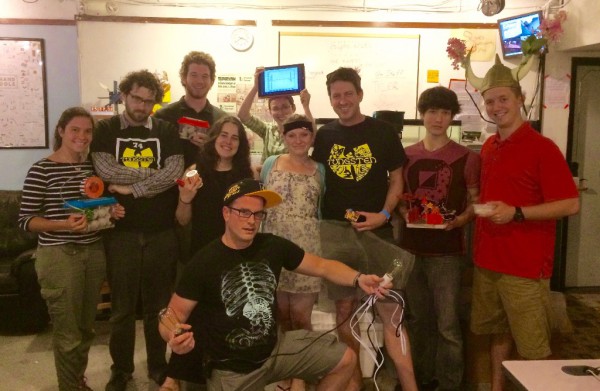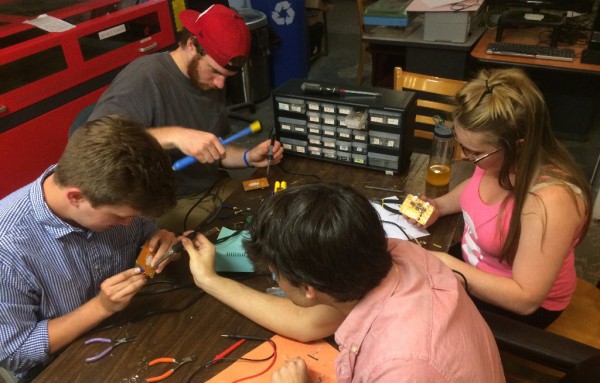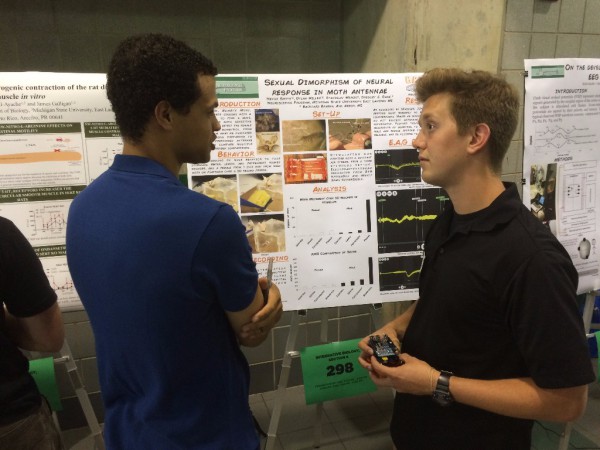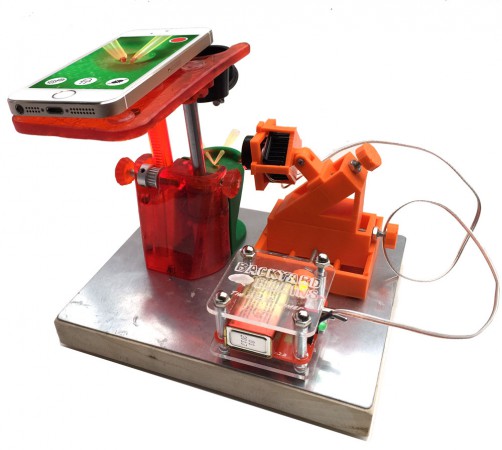Call for Undergraduates in biology or engineering fields
Do you have an interest in neuroscience? Electrical, Mechanical or Computer engineering? Want to develop your own experiments and publish your results? Learn to communicate with the public? Maybe even all of the above? Then you’re in luck!
The Backyard Brains Summer Internship is an intensive 10 week program for undergraduates to participate in hands-on neuroscience research and experiment design with award winning neuroscientists. This is the 3rd year of running our prestigious (and paid) summer program and this year it will run from May 23, 2016 to Aug 5, 2016 in Downtown Ann Arbor, MI. All applications must be received by 12:00pm ET on March 12 to be eligible. We will be notifying applicants status by March 21, 2016.
Apply to the Summer Internship Today!
All participants will be working on independent research projects, much like in a graduate school laboratory. We will have journal clubs to go over key papers, and you will be trained how to develop your own experiments and to build your own devices to perform those experiments. You will be collecting data, analyzing and presenting your results.
The end result of your summer internship will be a publishable experiment and video for our website, as well as a poster to be delivered at Undergraduate Research Poster Session of the Society for Neuroscience. In 2015, two of our students won awards for their poster presentations! We will work with each student to prepare a 10 minute TED-style talk for a public event in Ann Arbor, with the possibility of presenting at our annual TEDx event. We have also worked with students to continue refining their experiment writeups into manuscripts to publish first-authored papers in peer-reviewed journals.We have also worked with students to continue refining their manuscripts into first-authored peer-reviewed publications.
Apply to the Summer Internship Today!
Media Coverage of past Intern Projects
As interns, you will receive media coverage by the popular press. See below for previous examples:
Optogenetics Featured In Hackaday
“Cort Thompson is working with fruit flies genetically modified so a neuron will activate when they’re exposed to a specific pulse of light. It’s called optogenetics, and [Cort] has a few of these guys who have an ‘I’m tasting something sweet’ neuron activated when exposed to a pulse of red light”. Read the full article here
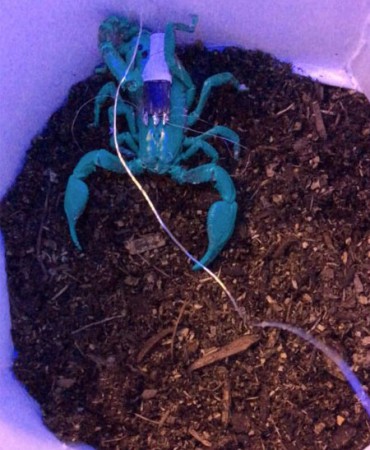
RoboScorpion Featured in Popular Mechanics
“Backyard Brains, a small Michigan-based company dedicated to spreading the word about neuroscience, has been running surgical experiments on these deadly arachnids for the past two months, using electrical current to induce them to strike. Dylan Miller, a summer intern working the project, insists it’s the first time that an electrical current has ever been used to remotely induce a scorpion to strike with its pedipalps (claws) and tail”. Read the full article here.
Your Mentors
This summer you will be trained by Ph.D. Neuroscientists, inventors, makers, seasoned engineers, and public speakers. With our team each intern will have a compelling demonstration that the public will be interested and delighted to see. For example, see our recent TED talk on some our recent work. Yours could be next!
Listen to a testimony from a former intern:
“It was fun and challenging, but extremely rewarding. Greg was a great mentor and I learned so much. More than any other experience I’ve had, this internship prepared me for graduate school and a career in research“-D. Miller, 2014 Intern
Make Discoveries!
This year’s projects will be our most interesting and exciting ones yet.
Human EEG Alarm Clock-EEG/EMG Recording of Sleep vs. Awake: What’s the perfect amount of sleep to get? And how do you figure that out on your own-you can’t predict the exact moment you’ll fall asleep. It turns out that right as this happens, your body’s muscles relax, then the different stages of sleep are easily detectable with an EEG. Combined with the latest research on sleep, we can determine exactly when someone goes to sleep, what stage of sleep they’re in, and then produce an alarm at the optimal time, biologically, for them to awaken.
Killer Dragonfly neural recording: Dragonflies-the perfect flying predators, living up to their namesake! Dragonfly eyes are incredibly complex and achieve near all-around vision, as well as extremely accurate in determining the position and velocity of a flying target. Neurons in their eyes are directly connected to their flight muscles (rather than going through their brain first), so they can change their flight path or speed near instantly. Your project will be to carefully map the dragonflies descending flight neurons by recording while playing videos of prey moving.
South American Electric Fish communicator: Weakly electric fish can both put out and sense electrical signals, and this is a key part of how they navigate their world-the signal they put out “reflects” off of things, working like a sonar. If another fish with a similar signal is too close, however, they risk “jamming” each other, effectively blinding them, so we want to investigate what kind of signals the fish avoids as indication of either another fish or a large object in their path and induce this behavior experimentally.
Jump! The Grasshopper vision project: Have you ever tried to catch a grasshopper or cricket by hand? Difficult stuff! It turns out they’re highly responsive to certain visual cues to indicate an oncoming object’s speed and direction. Their tiny brains have evolved a way to do complex math. With video on an iPad and a SpikerBox, you will tease apart this behavior experimentally, recording the neurons going from their eyes right to their legs.
The Floating African Electric Fish Finder: Rivers in Africa are teeming with fish constantly outputting all sorts of electric signals, and these signals can be used to identify the species, each having its own unique signal. With an easily used and portable device, even new species of electric fish may be discovered by the researchers in the area unable to acquire the expensive, complicated, and heavy equipment usually required.
The Unstoppable RoboRoach: Our current RoboRoach (the world’s first commercially available cyborg) works by activating sensory neurons in the cockroach antenna. But peripheral neurons adapt quickly. What if we dove deeper? Recent research has plugged cockroaches directly into The Matrix and controlling their movement at the level of the central complex of the brain, allowing possible longer control of movement and reducing their adaptation to the stimulus. Your job will be to get this working with our RoboRoach
The Werner Herzog CameraRoach: A camera enabled cyborg cockroach for making movies. In a recent interview,(https://techcrunch.com/2016/01/22/werner-herzog-on-his-documentary-lo-and-behold-cockroach-movies-and-moving-to-mars/) notable filmmaker Werner Herzog mentioned the idea of shooting films with a camera attached to a cockroach. That’s inspired us to make this into a reality-a RoboRoach that can be controlled and can shoot film (or at the least, take pictures.) Together, we can make a cockroach’s dream of winning an Oscar into reality!
The DIY Neuron: The quest for the first “true” spike of Backyard Brains. Don’t let that confuse you-we’ve recorded spikes before, but our quest now is to BYB-ize (accessible, inexpensive, and exciting) intracellularly recording action potentials. To do this, we’ll take Oocytes (the single cells frog eggs come from) which are visible to the naked eye, and genetically modify them to express neuronal ion channels and fire spontaneous action potentials. Peer inside this neuron-like cell, and see how to effect the spikes with ion changes.
Neuroscience of Free Will with EEG: Since the 80’s this has been both a subject of social sciences and Cold War science fiction. During this decade Benjamin Libet, a physiology researcher, investigated how the premotor potential corresponded to the felt intention to move. Libet found that motor activity in the brain precedes, by approximately half a second, our awareness of the intention to move. Isn’t that freaky? That’s why we want to replicate this with our own EEG equipment
Become a BYB Intern in 2016, and help start the neuro-revolution!
Apply to the Summer Internship Today!
FAQ’s
After receiving several emails and phone calls, we wanted to clarify a few points below:
Where does the internship take place?
You will be located at the Backyard Brains headquarters in downtown Ann Arbor (map). You will also be working out of our MakerSpace lab called “All Hands Active”.
How much are the interns paid?
The weekly payment is $404/wk. (Obama’s $10.10/hr)
How much is housing and can you help us find it?
While we do not pay for your housing, we are happy to inform you that summer housing is notoriously easy to find in Ann Arbor, as students leave for the summer and make available sublets. The price varies, but you can find sublet housing on craigslist for under $400. We recommend that you stay close to downtown/central campus.
I am not out of class until June. Can I start a bit later?
We feel that our interns need a full 10w to make significant progress on their projects. If you have a compelling reason on how this will not affect your project, we are willing to evaluate it on a case by case basis.
I am not an undergrad, can I still apply?
While our program is designed for undergraduates… If you are a college graduate, or a super smart High Schooler, we will accept your application.
Are projects assigned to interns or do the interns get some autonomy in deciding the course of their research?
The summer projects are described above and in the internship application. Each student will submit the project that they are interested during this process, or can suggest their own ideas. We take the applicant’s preferences in mind, and we pair a student with a project early on so that the intern will have some time to do some background reading and familiarize themselves with the organism/methods. While we have some idea of the direction or end result of a project, we encourage independent thought throughout the process-some of our most successful projects have come from slight deviations from the original goals. We will send out some suggested papers a few weeks before the program starts.
